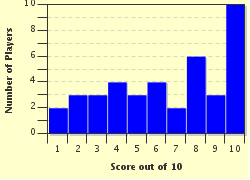Quiz Answer Key and Fun Facts
1. There are some very strange opening moves and tactics that some players - even grandmasters - adopt, but when it comes to rules of thumb, which of these is not usually a good idea to do in the opening?
2. Which of these things can a knight not do?
3. Which of these is not a good reason to offer a sacrifice?
4. Which of these moves is not possible under any circumstances if you are in check?
5. Which of these pieces can never move from a white square to another white square (or from black to black)?
6. Which of these 'types' of pawns is most commonly a good piece to have?
7. In most situations, which of these combinations of pieces is most powerful?
8. Most of the time, pawns are promoted to queens, but sometimes it can be useful to promote them to other pieces. But which of the following options is not a legal choice to promote a pawn to?
9. Which of these does not describe a type of draw?
10. In a smothered mate, which piece delivers the checkmate?
Source: Author
Lychrel
This quiz was reviewed by FunTrivia editor
WesleyCrusher before going online.
Any errors found in FunTrivia content are routinely corrected through our feedback system.

